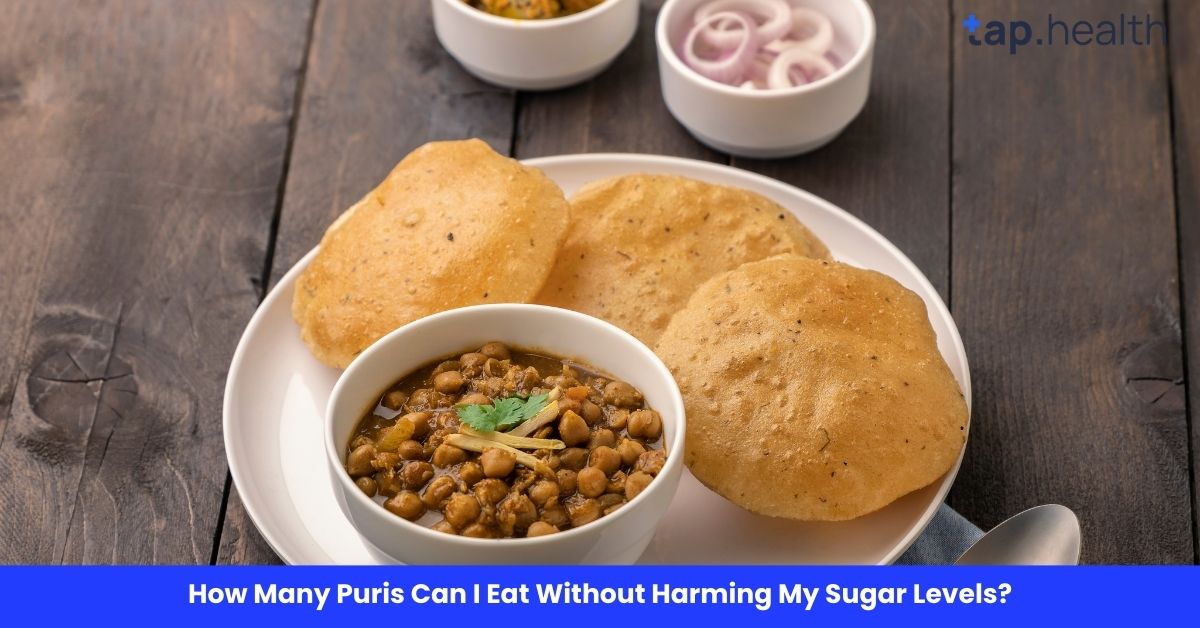Puris are a beloved Indian snack—crispy, golden, and delicious. But if you’re diabetic or need to manage your blood sugar levels, you might be wondering: “How many puris can I eat without harming my sugar levels?”
The good news is that it’s not about cutting out your favorite foods completely, but about making healthier choices and understanding how certain foods affect your blood sugar. In this article, we’ll dive into how puris impact sugar levels, how to enjoy them safely, and how you can make informed choices for a balanced diet.
What Are Puri and How Do They Affect Blood Sugar?
Puris are deep-fried bread made from refined flour (maida), often enjoyed with a variety of dishes like curries, lentils, and chutneys. While they’re delicious, it’s important to understand that puris, like many other fried and refined foods, have a significant impact on your blood sugar levels.
1. The Nutritional Content of Puri
A typical puri made from refined flour (maida) contains the following approximate nutritional breakdown:
- Calories: 150–200 per piece (depending on size)
- Carbohydrates: 20–25 grams
- Fats: 7–10 grams
- Protein: 2–3 grams
- Fiber: 1–2 grams
The key component to be mindful of here is the carbohydrate content. Carbs are converted into sugar (glucose) in the body, which directly affects your blood sugar levels. The higher the carb content, the more significant the impact on your blood sugar. The high fat content from deep-frying also adds extra calories and can impact heart health, which is important to monitor, especially for diabetics.
2. Glycemic Index of Puri
The glycemic index (GI) is a measure of how quickly foods cause blood sugar to rise. Foods with a high GI lead to rapid increases in blood sugar, which can be harmful for those with diabetes. Regular puris made from refined flour have a high glycemic index, meaning they can cause a quick spike in blood sugar after eating.
3. How Puris Affect Diabetics
For someone with diabetes, consuming high-GI foods like puri can lead to blood sugar spikes, which can be difficult to manage. Over time, these fluctuations can lead to complications such as:
- Insulin resistance: The body’s cells stop responding to insulin, making it harder to manage blood sugar.
- Weight gain: The high-fat and high-calorie content of puris can contribute to obesity, which worsens diabetes management.
- Increased risk of cardiovascular disease: People with diabetes are already at a higher risk for heart disease, and consuming high-fat, high-sugar foods like puris can further increase that risk.
How Many Puris Can You Eat Without Harming Your Sugar Levels?
When it comes to eating puris, the key is moderation and portion control. Since puris are high in carbs and fats, eating too many can cause blood sugar spikes. But how many can you safely eat without worrying about your blood sugar?
1. Recommended Portion Size for Diabetics
As a general guideline, it’s best to limit yourself to one or two small puris per meal, especially if they are made with refined flour. This portion should be considered alongside the rest of your meal, as other components like protein, vegetables, and fiber can help balance the overall impact on blood sugar.
Here’s why portion control matters:
- Carbohydrates and Blood Sugar: Carbs, especially refined carbs like those found in puris, can raise blood sugar levels quickly. By limiting your intake of puris, you prevent a sudden spike in blood sugar.
- Balancing Meals: If you choose to eat puri, balance it with protein (like dal, paneer, or chicken) and fiber-rich vegetables (like spinach or carrots). Protein and fiber help slow the absorption of sugars into your bloodstream, reducing the overall impact on blood sugar levels.
2. The Frequency of Eating Puri
The frequency at which you eat puris is another important factor to consider. Even if you stick to a small portion, eating puris regularly can still have an impact on your blood sugar control. It’s best to enjoy puris occasionally, rather than frequently, to prevent accumulating effects on blood sugar levels.
3. Adjusting for Activity Level
If you plan to eat puri, it’s important to take your activity level into account. Physical activity helps the body use glucose more efficiently, lowering the impact of carbs on blood sugar. If you’re physically active, you might be able to handle a slightly larger portion of puri compared to someone who is sedentary. However, portion control and moderation should always remain a priority.
Healthier Ways to Enjoy Puri for Diabetics
While eating puris in moderation can be safe for diabetics, it’s important to explore healthier alternatives that can make puris more suitable for blood sugar management.
1. Switch to Whole Wheat Flour or Multigrain Flour
Instead of using refined flour (maida), which has a high glycemic index, opt for whole wheat flour or multigrain flour. These options are lower in carbs and higher in fiber, which helps slow down the absorption of sugar and maintain more stable blood sugar levels.
2. Baked Puri Instead of Fried
One of the best ways to reduce the negative impact of puris on blood sugar is to bake them instead of deep-frying. Baked puris contain less fat, and the overall calorie content is reduced. While baked puris may not have the same crispy texture as fried puris, they are still a tasty and healthier alternative.
3. Use Alternative Flours
For a lower-carb option, try making puris with almond flour or coconut flour. These flours are lower in carbs, higher in fiber, and have a much lower glycemic index, making them better for blood sugar control. Additionally, these flours provide healthy fats and other nutrients that support overall health.
4. Stuffed Puri with Vegetables
To add more nutrition and fiber, you can make stuffed puris by adding vegetables like spinach, carrots, or even paneer. The added fiber from the vegetables helps slow the release of sugars into your bloodstream, making it a healthier option for diabetics.
5. Control Portion Size and Eat with Balance
If you still enjoy puris, make sure to control portion sizes and pair them with fiber-rich vegetables, proteins, or legumes. Combining puris with foods that have a low glycemic index helps balance blood sugar levels and prevents sharp spikes.
Tips for Managing Blood Sugar While Enjoying Puri
Here are a few tips to keep in mind when you want to enjoy puris without worrying about your blood sugar levels:
1. Monitor Your Blood Sugar Levels
If you’re diabetic, it’s crucial to regularly monitor your blood sugar levels. Testing before and after meals, including those with puris, will help you understand how your body reacts to certain foods. This way, you can adjust portion sizes or meal composition accordingly.
2. Mind the Accompaniments
What you eat with puri matters. Pair your puris with high-protein dishes (like dal or chickpeas) and fiber-rich vegetables. This helps slow the absorption of carbs and prevents blood sugar spikes.
3. Avoid Eating Puris on an Empty Stomach
Eating puris alone or on an empty stomach may lead to a faster rise in blood sugar levels. Always eat puris as part of a balanced meal that includes fiber, protein, and healthy fats to mitigate the impact on your blood sugar.
Real-Life Scenario
Let’s consider Rajesh, a 45-year-old diabetic who loves puri. Rajesh used to eat puri often, and he noticed his blood sugar levels spiking regularly. After consulting his nutritionist, he decided to limit his puri intake to once a week. He also started opting for whole wheat puri and baked puri, along with vegetables and lentils to balance his meal. Rajesh now enjoys puri occasionally, without worrying about harming his blood sugar levels.
Expert Contribution
1. Dr. Rajesh, Endocrinologist
Dr. Rajesh advises, “Diabetics can occasionally enjoy puri, but it’s important to be mindful of portion sizes and frequency. Substituting whole wheat for refined flour and baking instead of frying can help reduce the negative impact on blood sugar.”
2. Dr. Vivek, Nutritionist
Dr. Vivek adds, “Puri should be consumed as part of a well-balanced meal. Including fiber-rich vegetables or protein-rich foods helps slow down glucose absorption, making puri a safer option for diabetics when eaten in moderation.”
Recommendations Grounded in Proven Research and Facts
1. Low Glycemic Index Foods
Studies show that foods with a low glycemic index (GI), such as whole grains, help manage blood sugar levels more effectively. The slow digestion of these foods prevents rapid blood glucose spikes.
2. Incorporating Healthy Fats
Incorporating healthy fats like olive oil and avocado into your diet can improve insulin sensitivity and heart health, which is crucial for managing diabetes .
3. Portion Control and Meal Timing
Research suggests that managing portion sizes and eating meals at regular intervals plays a critical role in controlling blood sugar. Consuming puri in small portions and as part of a balanced meal can help minimize blood sugar spikes.
FAQs About Eating Puri for Diabetics
1. Can diabetics eat puri?
Yes, diabetics can eat puri, but it should be done in moderation. Choose healthier versions, like whole wheat or baked puris, and pair them with fiber and protein to help manage blood sugar levels.
2. How many puris can I eat without affecting my blood sugar?
For most diabetics, one to two small puris made from whole wheat or multigrain flour should be safe to eat in moderation. Eating more than that, especially if they are fried, can lead to blood sugar spikes.
3. What is the best flour to make puris for diabetics?
Whole wheat flour, multigrain flour, or low-carb options like almond flour or coconut flour are better choices for diabetics compared to refined flour (maida). These alternatives have a lower glycemic index and higher fiber content.
4. Can I eat puri daily if I have diabetes?
While eating puri occasionally is okay, consuming it daily, especially if it’s fried and made from refined flour, can lead to blood sugar spikes and complications over time. It’s best to limit consumption and focus on healthier alternatives.
5. Are there any low-carb puri options?
Yes, you can make low-carb puris using almond flour or coconut flour. These options are much lower in carbs compared to traditional puris made from refined flour and are more suitable for diabetics.
Conclusion
The key to enjoying puris without harming your sugar levels is moderation and smart choices. Diabetics can still enjoy puris, but they should be mindful of portion sizes, choose healthier flour alternatives, and pair puris with protein and fiber to balance blood sugar levels. While it’s tempting to indulge in puris, the key to long-term health is maintaining a balanced diet that prioritizes low-glycemic foods and portion control. By following these tips, you can enjoy puris occasionally without compromising your diabetes management.



